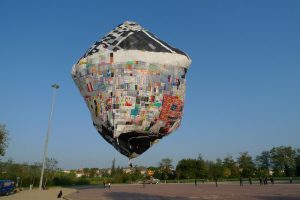The largest independent contemporary art event in Hungary, OFF-Biennale Budapest announces its third edition, titled INHALE! OFF-Biennale 2020 looks at the climate crisis, nationalisms, their entanglements, and artistic propositions that do more than just point to these problems.
INHALE!
Opening Days: April 24 – April 26, 2020
Exhibitions and Events: April 24 – May 31, 2020
OFF-Biennale Budapest is the largest independent contemporary art event in Hungary. It started in 2014 as a grassroots initiative, a “garage” biennale set up by a small group of art professionals in order to create a platform for exchange between art practitioners and other members of society, to strengthen the local independent art scene.
The notion of independence is key in the art scenes of Eastern Europe: thirty years after the change of regime, there is still no significant alternative to state financing in the visual arts. The current Hungarian government (2010– ) has capitalized on this monopoly. In correspondence with the broader societal changes it has engineered, the government has used legal and administrative procedures to create a centralized, party-loyal art infrastructure with dubious professional standards. At the same time, through austerity measures as well as defamatory and disciplinary acts, the state has weakened the independent, critical art scene. Reinforcing independence is thus at the core of OFF-Biennale Budapest.
OFF-Biennale boycotts the Hungarian public art infrastructure: it does not apply for state-managed funding and steers clear of state-run art institutions. This is a political statement as much as a practical solution to protect the freedom of artistic expression.
Rózsa Farkas, artist and founder of Arcadia Missa Gallery, wrote in i-D of the first edition in 2015: [OFF] is in existence through the hard work of those working outside of the state. The Biennale is not ‘Off’ in a negative way – it is not in opposition to, but rather it is a productive Other.
OFF is more than just a critical biennial: the biennale format is not an end in itself but a means to realize and sustain its mission, financially and infrastructurally. The biennial method allows the OFF core team to concentrate resources and attention every other year, building up new strategies each time to realize its programs. As a consequence, OFF has become more concise and more proactive over the course of its previous two editions, and has shifted increasingly towards commissioning and producing projects rather than only presenting them. While in 2015 there were 200 programs in around 100 venues, with artists from 22 countries, the 2017 iteration had 60 venues for its projects and around 150 participants from, again, 22 countries.
After these two successful editions, the third iteration focuses on 12 complex projects that OFF-Biennale co-produces and co-organizes. Projects in the 2020 edition, among many others, include the Hungarofuturist movement with international contributions by Henrike Naumann, Suzanne Treister, Igor & Ivan Buharov a.o.; the Museo Aero Solar by Aerocene (initiated by Tomás Saraceno and Alberto Paseotti); an Agency for Climate Imaginary conceived by Hungarian artist group xtro realm, with films by Armin Linke, Ursula Biemann, and Victor Brim; the exhibition Machinic Leviathan curated by Lívia Nolasco-Rózsás with artists such as Anca Benera and Arnold Estefan, Pablo de Soto, and Janek Simon; and News Medley, a collaboration between Alicja Rogalska, Katalin Erdődi, and local folk singing groups. The OFF curatorial team has worked in close collaboration with the initiators in Hungary and in the Hungarian diaspora on each aspect of their predominantly international projects, raising their visibility locally as well as internationally.
OFF thus has been a continuous experiment to perform and prefigure a sustainable and democratic institution in the civil realm, the methodologies of which bear both local and international relevance. Alongside producing and presenting art in Budapest, OFF also aims to participate in public discourse on pressing issues, to enhance infrastructures of emancipation and dissent locally and, in the long run, internationally.
London-based curators and art historians Maja and Reuben Fowkes noted about the 2017 iteration that
[b]oth through its choice of theme and self-organizational collaborative format, [the OFF-Biennale Budapest 2017] could be seen as a practical exercise in rebuilding the culture of democracy through contemporary art.
INHALE!
The third edition of OFF-Biennale Budapest, INHALE!, takes the seminal political poem “A Breath of Air!” by 20th-century Hungarian poet Attila József as its point of departure. The poem was written in 1935, a time when the social catastrophe of the Great Depression rearranged the political map of Europe, and fascism ruled over half of the continent. After the crisis of 2008, the political climate has, again, moved into a more xenophobic, fascist-leaning direction in Hungary as well as in other countries of the world. And it is not only the political climate that has changed: the climate of the Earth itself also underwent dramatic changes due to human activities. Thus, in our 21st-century reading of the poem, a “breath of air” simultaneously refers to the galloping climate crisis and the fundamental freedoms threatened by populist regimes and by global capital.
What does contemporary art have to say when scientific facts are taken over by conspiracy theories, when myths replace history, and creativity itself has become subject to co-option? The presented projects do not only point to problems. Going beyond criticism, they deliver utopian, playful, or very tangible suggestions and alternatives; about various ethnofuturist movements or transnational alliances that hijack nationalist discourses. They speak to questions about what we should eat, or how we should adapt to conditions of deep poverty in order to survive, or about how a transnational museum of Roma contemporary art should operate. Thus, INHALE! is neither a desperate call for help, nor simply a demand, but rather an imperative. It is a direct reference to how we must take a deep breath and take action for clean air, for the protection of our freedom, for the liberation of our imagination—to create and preserve conditions and places for breathing freely.


